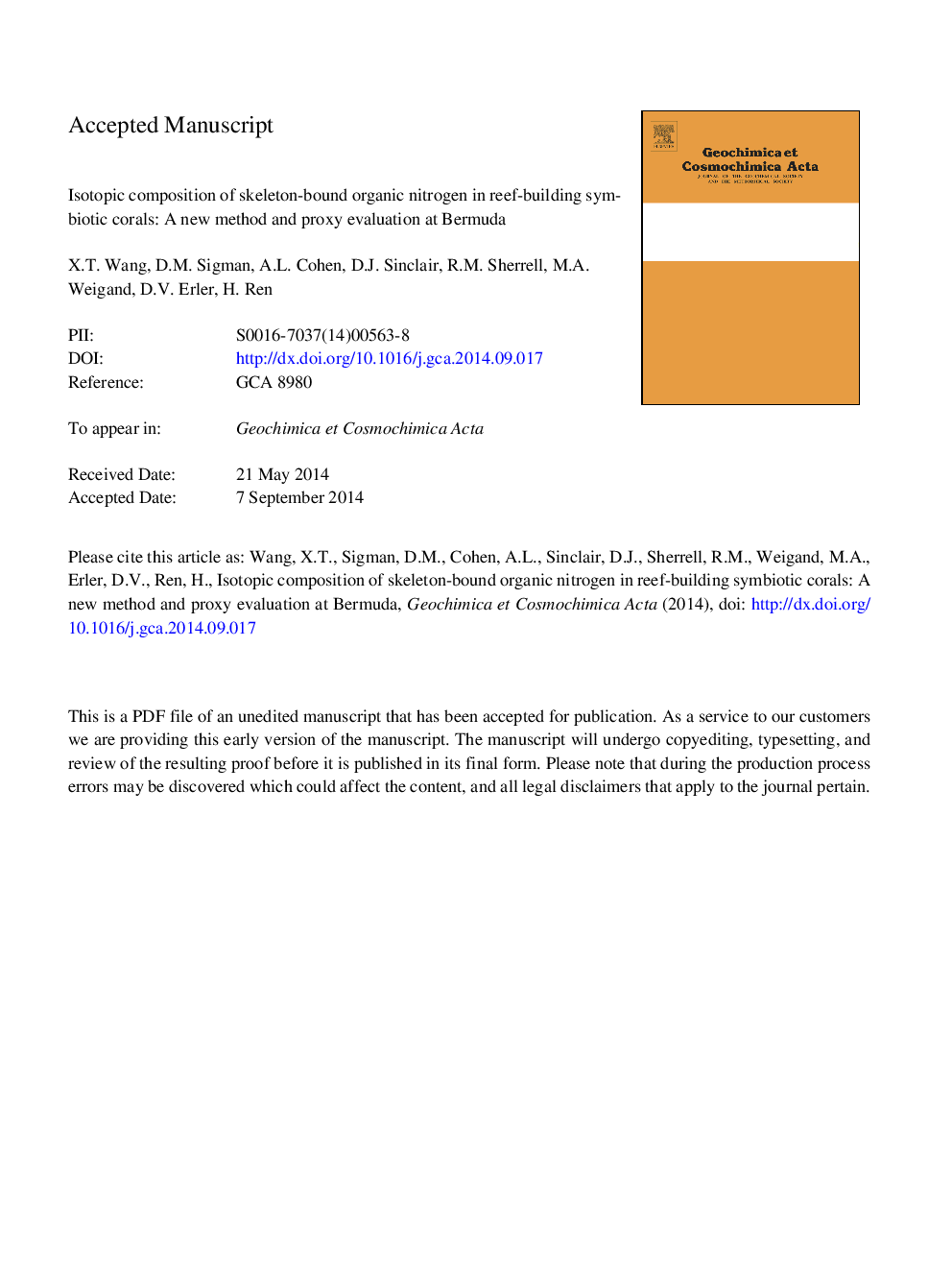| کد مقاله | کد نشریه | سال انتشار | مقاله انگلیسی | نسخه تمام متن |
|---|---|---|---|---|
| 6438167 | 1638009 | 2015 | 45 صفحه PDF | دانلود رایگان |
عنوان انگلیسی مقاله ISI
Isotopic composition of skeleton-bound organic nitrogen in reef-building symbiotic corals: A new method and proxy evaluation at Bermuda
ترجمه فارسی عنوان
ترکیب ایزوتوپ نیتروژن آلی ناقل اسکلت در مرجانهای همزیستی صخره ای: روش جدید و ارزیابی پروکسی در برمودا
دانلود مقاله + سفارش ترجمه
دانلود مقاله ISI انگلیسی
رایگان برای ایرانیان
موضوعات مرتبط
مهندسی و علوم پایه
علوم زمین و سیارات
ژئوشیمی و پترولوژی
چکیده انگلیسی
The skeleton-bound organic nitrogen in reef-building symbiotic corals may be a high-resolution archive of ocean nitrogen cycle dynamics and a tool for understanding coral biogeochemistry and physiological processes. However, the existing methods for measuring the isotopic composition of coral skeleton-bound organic nitrogen (hereafter, CS-δ15N) either require too much skeleton material or have low precision, limiting the applications of this relatively new proxy. In addition, the controlling factors on CS-δ15N remain poorly understood: the δ15N of source nitrogen and the internal nitrogen cycle of the coral/zooxanthellae symbiosis may both be important. Here, we describe a new (“persulfate/denitrifier”-based) method for measuring CS-δ15N, requiring only 5 mg of skeleton material and yielding a long-term precision better than 0.2â° (1Ï). Using this new method, we investigate CS-δ15N at Bermuda. Ten modern Diploria labyrinthiformis coral cores/colonies from 4 sampling sites were measured for CS-δ15N. Nitrogen concentrations (nitrate + nitrite, ammonium, and dissolved organic nitrogen) and δ15N of plankton were also measured at these coral sites. Among the 4 sampling sites, CS-δ15N shows an increase with proximity to the island, from â¼3.8â° to â¼6.8â° vs. atmospheric N2, with the northern offshore site having a CS-δ15N 1-2â° higher than the δ15N of thermocline nitrate in the surrounding Sargasso Sea. Two annually resolved CS-δ15N time series suggest that the offshore-inshore CS-δ15N gradient has persisted since at least the 1970s. Plankton δ15N among these 4 sites also has an inshore increase, but of only â¼1â°. Coral physiological change must explain the remaining (â¼2â°) inshore increase in CS-δ15N, and previous work points to the coral/zooxanthellae N cycle as a control on host tissue (and thus carbonate skeletal) δ15N. The CS-δ15N gradient is hypothesized to result mainly from varying efficiency in the internal nitrogen recycling of the coral/zooxanthellae symbiosis. It is proposed that, in more productive inshore waters, greater food uptake by the coral causes a greater fraction of its low-δ15N regenerated ammonium to be excreted rather than assimilated by zooxanthellae, raising the δ15N of the inshore corals. If so, coral tissue- and CS-δ15N may prove of use to reconstruct and monitor the state of the coral/zooxanthellae symbiosis over space and time.
ناشر
Database: Elsevier - ScienceDirect (ساینس دایرکت)
Journal: Geochimica et Cosmochimica Acta - Volume 148, 1 January 2015, Pages 179-190
Journal: Geochimica et Cosmochimica Acta - Volume 148, 1 January 2015, Pages 179-190
نویسندگان
X.T. Wang, D.M. Sigman, A.L. Cohen, D.J. Sinclair, R.M. Sherrell, M.A. Weigand, D.V. Erler, H. Ren,
